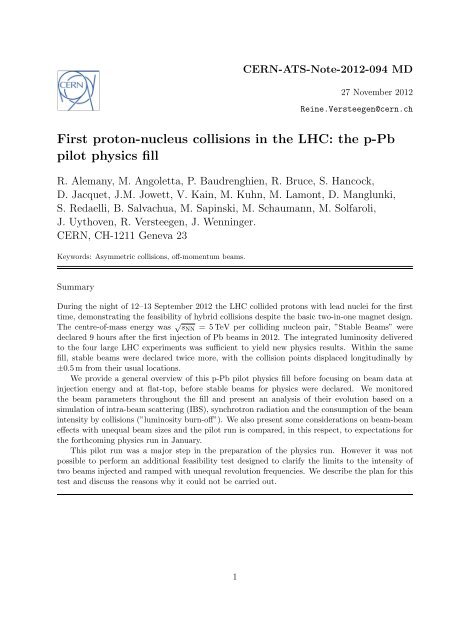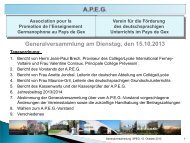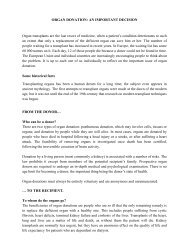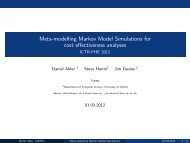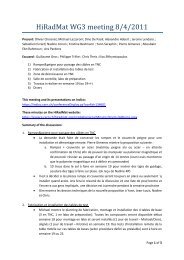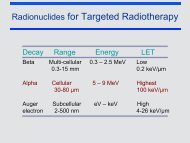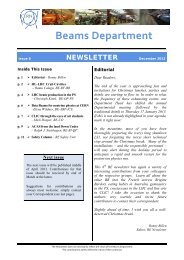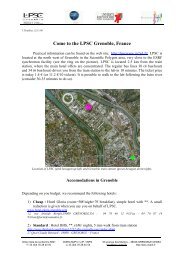First proton-nucleus collisions in the LHC: the p-Pb pilot ... - Cern
First proton-nucleus collisions in the LHC: the p-Pb pilot ... - Cern
First proton-nucleus collisions in the LHC: the p-Pb pilot ... - Cern
Create successful ePaper yourself
Turn your PDF publications into a flip-book with our unique Google optimized e-Paper software.
CERN-ATS-Note-2012-094 MD<br />
27 November 2012<br />
Re<strong>in</strong>e.Versteegen@cern.ch<br />
<strong>First</strong> <strong>proton</strong>-<strong>nucleus</strong> <strong>collisions</strong> <strong>in</strong> <strong>the</strong> <strong>LHC</strong>: <strong>the</strong> p-<strong>Pb</strong><br />
<strong>pilot</strong> physics fill<br />
R. Alemany, M. Angoletta, P. Baudrenghien, R. Bruce, S. Hancock,<br />
D. Jacquet, J.M. Jowett, V. Ka<strong>in</strong>, M. Kuhn, M. Lamont, D. Manglunki,<br />
S. Redaelli, B. Salvachua, M. Sap<strong>in</strong>ski, M. Schaumann, M. Solfaroli,<br />
J. Uythoven, R. Versteegen, J. Wenn<strong>in</strong>ger.<br />
CERN, CH-1211 Geneva 23<br />
Keywords: Asymmetric <strong>collisions</strong>, off-momentum beams.<br />
Summary<br />
Dur<strong>in</strong>g <strong>the</strong> night of 12–13 September 2012 <strong>the</strong> <strong>LHC</strong> collided <strong>proton</strong>s with lead nuclei for <strong>the</strong> first<br />
time, demonstrat<strong>in</strong>g <strong>the</strong> feasibility of hybrid <strong>collisions</strong> despite <strong>the</strong> basic two-<strong>in</strong>-one magnet design.<br />
The centre-of-mass energy was √ sNN = 5 TeV per collid<strong>in</strong>g nucleon pair, ”Stable Beams” were<br />
declared 9 hours after <strong>the</strong> first <strong>in</strong>jection of <strong>Pb</strong> beams <strong>in</strong> 2012. The <strong>in</strong>tegrated lum<strong>in</strong>osity delivered<br />
to <strong>the</strong> four large <strong>LHC</strong> experiments was sufficient to yield new physics results. With<strong>in</strong> <strong>the</strong> same<br />
fill, stable beams were declared twice more, with <strong>the</strong> collision po<strong>in</strong>ts displaced longitud<strong>in</strong>ally by<br />
±0.5 m from <strong>the</strong>ir usual locations.<br />
We provide a general overview of this p-<strong>Pb</strong> <strong>pilot</strong> physics fill before focus<strong>in</strong>g on beam data at<br />
<strong>in</strong>jection energy and at flat-top, before stable beams for physics were declared. We monitored<br />
<strong>the</strong> beam parameters throughout <strong>the</strong> fill and present an analysis of <strong>the</strong>ir evolution based on a<br />
simulation of <strong>in</strong>tra-beam scatter<strong>in</strong>g (IBS), synchrotron radiation and <strong>the</strong> consumption of <strong>the</strong> beam<br />
<strong>in</strong>tensity by <strong>collisions</strong> (”lum<strong>in</strong>osity burn-off”). We also present some considerations on beam-beam<br />
effects with unequal beam sizes and <strong>the</strong> <strong>pilot</strong> run is compared, <strong>in</strong> this respect, to expectations for<br />
<strong>the</strong> forthcom<strong>in</strong>g physics run <strong>in</strong> January.<br />
This <strong>pilot</strong> run was a major step <strong>in</strong> <strong>the</strong> preparation of <strong>the</strong> physics run. However it was not<br />
possible to perform an additional feasibility test designed to clarify <strong>the</strong> limits to <strong>the</strong> <strong>in</strong>tensity of<br />
two beams <strong>in</strong>jected and ramped with unequal revolution frequencies. We describe <strong>the</strong> plan for this<br />
test and discuss <strong>the</strong> reasons why it could not be carried out.<br />
1
Contents<br />
1 Introduction 4<br />
2 Overview of <strong>the</strong> run 5<br />
3 From first <strong>collisions</strong> to stable beams 9<br />
4 Evolution of beam parameters 14<br />
5 Collid<strong>in</strong>g beams of different transverse sizes 23<br />
6 MD on <strong>in</strong>tensity limit 26<br />
7 Conclusions and perspectives for <strong>the</strong> com<strong>in</strong>g physics run 28<br />
List of Figures<br />
1 Fill<strong>in</strong>g scheme . . . . . . . . . . . . . . . . . . . . . . . . . . . . . . . . . . . 6<br />
2 RF frequencies dur<strong>in</strong>g <strong>the</strong> ramp . . . . . . . . . . . . . . . . . . . . . . . . . 7<br />
3 Beam positions dur<strong>in</strong>g re-phas<strong>in</strong>g . . . . . . . . . . . . . . . . . . . . . . . . 8<br />
4 Collisions and lum<strong>in</strong>osity production . . . . . . . . . . . . . . . . . . . . . . 8<br />
5 Vertical tunes and B1 <strong>in</strong>tensity . . . . . . . . . . . . . . . . . . . . . . . . . 9<br />
6 Orbits at <strong>the</strong> primary colimators . . . . . . . . . . . . . . . . . . . . . . . . 10<br />
7 Beam profiles at primary collimators . . . . . . . . . . . . . . . . . . . . . . 11<br />
8 Beam losses at primary collimators . . . . . . . . . . . . . . . . . . . . . . . 12<br />
9 Loss maps <strong>in</strong> collision . . . . . . . . . . . . . . . . . . . . . . . . . . . . . . . 13<br />
10 <strong>Pb</strong>-emittance at <strong>in</strong>jection energy . . . . . . . . . . . . . . . . . . . . . . . . 14<br />
11 Intensities dur<strong>in</strong>g physics . . . . . . . . . . . . . . . . . . . . . . . . . . . . . 16<br />
12 Emittances dur<strong>in</strong>g physics . . . . . . . . . . . . . . . . . . . . . . . . . . . . 16<br />
13 Bunch lengths dur<strong>in</strong>g physics . . . . . . . . . . . . . . . . . . . . . . . . . . 17<br />
14 Proton parameters dur<strong>in</strong>g physics . . . . . . . . . . . . . . . . . . . . . . . . 18<br />
15 <strong>Pb</strong> parameters dur<strong>in</strong>g physics . . . . . . . . . . . . . . . . . . . . . . . . . . 19<br />
16 Coupl<strong>in</strong>g dur<strong>in</strong>g change to collision tunes . . . . . . . . . . . . . . . . . . . . 19<br />
17 Calibration of BGI data us<strong>in</strong>g WS . . . . . . . . . . . . . . . . . . . . . . . . 20<br />
18 Emittance evolution measured us<strong>in</strong>g WS and BGIs . . . . . . . . . . . . . . 22<br />
19 <strong>Pb</strong> tune distributions from beam-beam <strong>in</strong>teraction with <strong>proton</strong>s . . . . . . . 24<br />
20 Predicted <strong>Pb</strong> tune distributions . . . . . . . . . . . . . . . . . . . . . . . . . 25<br />
21 Miscount<strong>in</strong>g of number of bunches . . . . . . . . . . . . . . . . . . . . . . . . 26<br />
22 Delivered lum<strong>in</strong>osity dur<strong>in</strong>g <strong>pilot</strong> physics run as estimated from measured<br />
beam parameters. . . . . . . . . . . . . . . . . . . . . . . . . . . . . . . . . 28<br />
List of Tables<br />
1 Ma<strong>in</strong> events of <strong>the</strong> fill . . . . . . . . . . . . . . . . . . . . . . . . . . . . . . . 5<br />
2
2 <strong>Pb</strong> parameters for IBS simulation at <strong>in</strong>jection . . . . . . . . . . . . . . . . . 15<br />
3 Proton and <strong>Pb</strong> parameters for simulation at flat top . . . . . . . . . . . . . . 17<br />
4 Pixel size and po<strong>in</strong>t spread of BGI . . . . . . . . . . . . . . . . . . . . . . . 21<br />
5 Beam-beam effects of unequal beam sizes . . . . . . . . . . . . . . . . . . . . 23<br />
6 Beam-beam parameters for <strong>pilot</strong> fill and physics run . . . . . . . . . . . . . . 25<br />
7 Parameters reached dur<strong>in</strong>g <strong>the</strong> p-<strong>Pb</strong> <strong>pilot</strong> physics fill . . . . . . . . . . . . . 29<br />
3
1 Introduction<br />
As a consequence of <strong>the</strong> two-<strong>in</strong>-one magnet design and <strong>the</strong>ir different mass to charge ratios,<br />
<strong>proton</strong> and <strong>Pb</strong> beams do not have <strong>the</strong> same revolution frequencies <strong>in</strong> <strong>the</strong> <strong>LHC</strong> [1, 2, 3].<br />
Injection from <strong>the</strong> SPS at beam energy E = 450 Z GeV and <strong>the</strong> ramp up to E = 4 Z TeV<br />
have to be done with unlocked RF frequencies. Only at flat top, when <strong>the</strong> <strong>in</strong>duced orbit is<br />
small enough, <strong>the</strong> RF frequencies are locked toge<strong>the</strong>r. The maximum central orbit shift is<br />
<strong>the</strong>n 0.5 mm.<br />
As long as <strong>the</strong> frequencies are separated, <strong>the</strong> encounter po<strong>in</strong>ts between bunches of <strong>the</strong><br />
two beams are shift<strong>in</strong>g around <strong>the</strong> r<strong>in</strong>g, modulat<strong>in</strong>g <strong>the</strong> long range beam-beam <strong>in</strong>teractions.<br />
This phenomenon severely limited <strong>the</strong> D-Au operation of RHIC when it was tried with <strong>the</strong><br />
same rigidities <strong>in</strong> <strong>the</strong> two r<strong>in</strong>gs [4]. The ma<strong>in</strong> goals of <strong>the</strong> feasibility tests for p-<strong>Pb</strong> <strong>in</strong> <strong>the</strong><br />
<strong>LHC</strong> were to <strong>in</strong>ject and ramp <strong>the</strong> different beams with unlocked frequencies, <strong>in</strong> order to<br />
learn more about <strong>the</strong> effects of mov<strong>in</strong>g encounters, and to get more <strong>in</strong>formation about <strong>the</strong><br />
p-<strong>in</strong>tensity limit for <strong>Pb</strong> stability. The first part of <strong>the</strong> programme was carried out <strong>in</strong> 2011,<br />
namely <strong>the</strong> <strong>in</strong>jection and ramp of a few p-bunches aga<strong>in</strong>st a few <strong>Pb</strong>-bunches, and <strong>in</strong>jection<br />
a few <strong>Pb</strong>-bunches aga<strong>in</strong>st about 300 p-bunches [5]. The second part was cancelled <strong>in</strong> 2011<br />
and was rescheduled to take place one day before <strong>the</strong> <strong>pilot</strong> run.<br />
The p-<strong>Pb</strong> <strong>pilot</strong> physics run was needed for both <strong>the</strong> experiments and <strong>the</strong> operation of <strong>the</strong><br />
<strong>in</strong>jector cha<strong>in</strong> and <strong>the</strong> <strong>LHC</strong> <strong>in</strong> order to prepare <strong>the</strong> com<strong>in</strong>g p-<strong>Pb</strong> run <strong>in</strong> January 2013. The<br />
first <strong>Pb</strong> beam of <strong>the</strong> year was <strong>in</strong>jected <strong>in</strong>to <strong>the</strong> <strong>LHC</strong>, both <strong>the</strong> p-beam and <strong>the</strong> <strong>Pb</strong>-beam were<br />
ramped up to 4 Z TeV with unlocked RF frequencies. They were <strong>the</strong>n brought <strong>in</strong>to <strong>collisions</strong><br />
and “Stable Beams” were declared <strong>in</strong> just over 9 hours. All four large experiments, ALICE,<br />
ATLAS, CMS and, for <strong>the</strong> first time <strong>in</strong> <strong>the</strong> heavy-ion programme, <strong>LHC</strong>b, participated <strong>in</strong><br />
this run. The first p-<strong>Pb</strong> data were taken for about 8 hours. After <strong>the</strong> first 5 hours of data<br />
acquisition, <strong>the</strong> <strong>in</strong>teraction po<strong>in</strong>ts were shifted by −0.5 m and <strong>the</strong>n by +0.5 m, as requested<br />
by ALICE.<br />
This note presents an analysis of <strong>the</strong> <strong>pilot</strong> fill. <strong>First</strong>, <strong>in</strong> Section 2, a general overview and<br />
<strong>the</strong> context of <strong>the</strong> run is given. Proton losses observed while putt<strong>in</strong>g beams <strong>in</strong>to <strong>collisions</strong><br />
are analysed <strong>in</strong> Section 3, toge<strong>the</strong>r with <strong>the</strong> loss maps done before go<strong>in</strong>g <strong>in</strong>to physics.<br />
Special care was taken to monitor <strong>the</strong> beams’ profiles dur<strong>in</strong>g <strong>the</strong> whole fill. Transverse<br />
emittances, bunch <strong>in</strong>tensities and bunch length evolution are compared with simulation of<br />
<strong>in</strong>tra-beam scatter<strong>in</strong>g (IBS) and radiation damp<strong>in</strong>g <strong>in</strong> Section 4, at <strong>in</strong>jection and dur<strong>in</strong>g<br />
physics. As <strong>the</strong> <strong>proton</strong> beam transverse emittance delivered by <strong>the</strong> <strong>in</strong>jectors can be significantly<br />
reduced compared to <strong>the</strong> nom<strong>in</strong>al value, one of <strong>the</strong> concerns for p-<strong>Pb</strong> operation is <strong>the</strong><br />
stability of collid<strong>in</strong>g beams of unequal transverse dimensions. This is studied <strong>in</strong> Section 5.<br />
The <strong>pilot</strong> run was very successful but a factor of several hundreds <strong>in</strong> lum<strong>in</strong>osity is still to<br />
be ga<strong>in</strong>ed for <strong>the</strong> ma<strong>in</strong> physics run <strong>in</strong> January-February 2013. Many uncerta<strong>in</strong>ties rema<strong>in</strong><br />
as bad luck three times prevented us from carry<strong>in</strong>g out <strong>the</strong> feasibility tests as planned, first<br />
<strong>in</strong> November 2011, <strong>the</strong>n aga<strong>in</strong>, twice, <strong>in</strong> September 2012. The last section of <strong>the</strong> note is<br />
dedicated to <strong>the</strong> second part of <strong>the</strong> tests, <strong>the</strong> Mach<strong>in</strong>e Development (MD) on <strong>proton</strong> beam<br />
<strong>in</strong>tensity limit. Motivations are given, and <strong>the</strong> experience and <strong>in</strong>formation acquired so far<br />
are discussed.<br />
4
2 Overview of <strong>the</strong> run<br />
15:45 Injection of <strong>the</strong> first <strong>Pb</strong> bunch.<br />
17:37 Injection of <strong>proton</strong>s <strong>in</strong> B1.<br />
18:54 Injection of Lead <strong>in</strong> B2.<br />
19:19 Beam dump dur<strong>in</strong>g <strong>the</strong> ramp due to TCTs <strong>in</strong>terlocks.<br />
22:40 Start of ramp.<br />
23:07 Lock<strong>in</strong>g <strong>the</strong> RF frequencies toge<strong>the</strong>r.<br />
23:30 <strong>First</strong> <strong>collisions</strong>.<br />
00:43 Start of loss maps.<br />
1:27 Stable Beams declared.<br />
6:25 Stable beams, IP moved by −0.5 m <strong>in</strong> ALICE.<br />
7:55 Stable beams, IP moved by +0.5 m <strong>in</strong> ALICE.<br />
9:35 Beam dump by operators.<br />
Table 1: Ma<strong>in</strong> events of <strong>the</strong> p-<strong>Pb</strong> <strong>pilot</strong> physics fill on 12–13 September 2012.<br />
The p-<strong>Pb</strong> <strong>pilot</strong> physics fill was scheduled on Wednesday, 12 September 2012 from 16:00.<br />
It was supposed to occur one day after <strong>the</strong> second part of <strong>the</strong> p-<strong>Pb</strong> feasibility tests so that<br />
possible problems related to <strong>in</strong>jection or ramp<strong>in</strong>g with unlocked frequencies would already<br />
have been dealt with. But a number of technical problems occurred dur<strong>in</strong>g <strong>the</strong> MD on<br />
Monday, 10/9/2012, prevent<strong>in</strong>g us from tak<strong>in</strong>g advantage of it for <strong>the</strong> <strong>pilot</strong> run. As a result<br />
<strong>the</strong> <strong>in</strong>jection and ramp had to be commissioned dur<strong>in</strong>g <strong>the</strong> <strong>pilot</strong> run. As <strong>the</strong> high-beta physics<br />
run preced<strong>in</strong>g us was f<strong>in</strong>ished, we started a little earlier than foreseen and <strong>the</strong> first <strong>Pb</strong> bunch<br />
was <strong>in</strong>jected before 16:00. Its <strong>in</strong>tensity was about 7 × 10 9 charges (or 8.5 × 10 7 208 <strong>Pb</strong> 82+<br />
nuclei). In physics runs, it is preferable to <strong>in</strong>ject <strong>Pb</strong> after <strong>proton</strong>s to m<strong>in</strong>imise <strong>the</strong> time spent<br />
by <strong>the</strong> <strong>Pb</strong> beam at <strong>in</strong>jection and limit <strong>the</strong> <strong>in</strong>fluence of IBS. The low <strong>in</strong>tensity <strong>proton</strong> beam<br />
was <strong>in</strong>jected at 17:37, with about 1.2 × 10 10 charges per bunch. The <strong>in</strong>jection of <strong>Pb</strong> was<br />
delayed due to a tim<strong>in</strong>g problem between <strong>the</strong> SPS and <strong>the</strong> <strong>LHC</strong>. Two bunches were <strong>in</strong>jected<br />
at 18:13 and dumped to f<strong>in</strong>ally start a clean <strong>in</strong>jection of <strong>Pb</strong> <strong>in</strong> Beam 2 (B2) at 18:54.<br />
It was decided by <strong>the</strong> Collimation Group and Mach<strong>in</strong>e Protection that loss maps had to<br />
be performed before go<strong>in</strong>g <strong>in</strong>to physics, and that collimators’ sett<strong>in</strong>gs had to be modified. In<br />
order not to lose <strong>the</strong> fill while do<strong>in</strong>g <strong>the</strong> loss maps, two additional bunches were <strong>in</strong>serted <strong>in</strong><br />
<strong>the</strong> fill<strong>in</strong>g scheme for both beams (one for each plane). Loss maps could <strong>the</strong>n be done thanks<br />
to bunch-by-bunch excitation <strong>in</strong>duced by <strong>the</strong> transverse damper (ADT) [6]. The <strong>in</strong>itial fill<strong>in</strong>g<br />
scheme was composed of 13 bunches, giv<strong>in</strong>g 8 <strong>collisions</strong> <strong>in</strong> each of <strong>the</strong> four experiments plus<br />
one non-collid<strong>in</strong>g bunch for beam parameters analysis. The details are shown <strong>in</strong> Figure 1.<br />
The new collimator sett<strong>in</strong>gs were implemented but energy thresholds were not modified<br />
accord<strong>in</strong>gly and <strong>the</strong> TCTs’ position <strong>in</strong>terlocks dumped <strong>the</strong> beams dur<strong>in</strong>g <strong>the</strong> ramp. We had<br />
5
Figure 1: Screen copy of <strong>the</strong> <strong>LHC</strong> fill<strong>in</strong>g scheme application show<strong>in</strong>g <strong>the</strong> fill<strong>in</strong>g scheme used<br />
for <strong>the</strong> p-<strong>Pb</strong> <strong>pilot</strong> physics fill.<br />
to go back to usual collimator sett<strong>in</strong>gs for p-p physics and <strong>the</strong> second attempt to ramp was<br />
successful, between 22:40 and 22:52. Figure 2 shows <strong>the</strong> <strong>in</strong>crease of unlocked frequencies.<br />
At E = 4 Z TeV, <strong>the</strong> frequency difference was reduced to ∆fRF ≈ 60 Hz.<br />
Once at flat top, <strong>the</strong> automatic re-phas<strong>in</strong>g procedure was used to lock <strong>the</strong> RF frequencies<br />
toge<strong>the</strong>r [7]. It made <strong>the</strong> orbit go off-momentum as illustrated by mean beam position <strong>in</strong> <strong>the</strong><br />
r<strong>in</strong>gs <strong>in</strong> Figure 3. No squeeze was planned so <strong>the</strong> β ∗ at IP1, IP2, IP5, IP8 were 11 m, 10 m,<br />
11 m, 10 m. Separations were collapsed and <strong>the</strong> adjustment phase started at 23:30. The loss<br />
maps were performed from 00:43, and stable beams were declared at 01:27. After 5 hours<br />
of data tak<strong>in</strong>g <strong>the</strong> IPs were shifted by −50 cm and <strong>the</strong>n by +50 cm for additional data<br />
acquisition. The beams were f<strong>in</strong>ally dumped by operators to cont<strong>in</strong>ue <strong>the</strong> planned schedule<br />
at 09:35 on Thursday, 13 September. Table 1 summarizes <strong>the</strong> ma<strong>in</strong> steps of <strong>the</strong> run.<br />
Figure 4 shows <strong>the</strong> beam <strong>in</strong>tensities through <strong>the</strong> run and <strong>the</strong> lum<strong>in</strong>osity production<br />
<strong>in</strong> ATLAS and ALICE as examples. The absolute values of lum<strong>in</strong>osities are unreliable as<br />
lum<strong>in</strong>osities of this completely new k<strong>in</strong>d of collision were not calibrated. We clearly see<br />
<strong>the</strong> effect of IBS on B2 (<strong>Pb</strong>) <strong>in</strong>tensity, provok<strong>in</strong>g a cont<strong>in</strong>uous decrease of <strong>the</strong> number of<br />
charges. It is negligible for Beam 1 (B1) thanks to <strong>in</strong>tensities much smaller than <strong>in</strong> usual<br />
p-p operation. After <strong>the</strong> ramp, depicted by <strong>the</strong> energy curve <strong>in</strong> blue, one can notice a drop<br />
of <strong>proton</strong> <strong>in</strong>tensity around 23:35. This will be discussed <strong>in</strong> <strong>the</strong> next section. Then losses <strong>in</strong><br />
both beams around 01:00 correspond to <strong>the</strong> loss maps, where two bunches were successively<br />
blown up by <strong>the</strong> ADT <strong>in</strong> B1, <strong>the</strong>n <strong>in</strong> B2.<br />
6
p-beam frequency<br />
<strong>Pb</strong>-beam frequency<br />
Figure 2: Evolution of RF frequencies dur<strong>in</strong>g <strong>the</strong> ramp of p and <strong>Pb</strong> beams. The frequencies<br />
were locked toge<strong>the</strong>r at 23:07.<br />
7
Figure 3: Horizontal mean position of <strong>the</strong> beams dur<strong>in</strong>g <strong>the</strong> re-phas<strong>in</strong>g procedure. Top: B1,<br />
p-beam; bottom: B2, <strong>Pb</strong>-beam.<br />
Figure 4: Gett<strong>in</strong>g to <strong>collisions</strong> and produc<strong>in</strong>g lum<strong>in</strong>osity dur<strong>in</strong>g <strong>pilot</strong> run.<br />
8
3 From first <strong>collisions</strong> to stable beams<br />
Losses on TCPs<br />
Once <strong>the</strong> RF frequencies were locked toge<strong>the</strong>r after <strong>the</strong> ramp, we entered <strong>the</strong> Adjust phase to<br />
optimise <strong>collisions</strong> without go<strong>in</strong>g through any squeeze procedure. As mentioned earlier, we<br />
observed a sudden drop of <strong>proton</strong> <strong>in</strong>tensity at this stage . Look<strong>in</strong>g more closely at <strong>the</strong> data,<br />
it was found to be correlated with <strong>the</strong> change of tunes from <strong>in</strong>jection (0.28, 0.31) to collision<br />
values (0.31, 0.32), as shown <strong>in</strong> Figure 5. The tune change was effected locally us<strong>in</strong>g <strong>the</strong><br />
dispersion suppressor quadrupoles <strong>in</strong> IR1 and IR5. This is not as smooth as a global change<br />
and <strong>the</strong>refore <strong>in</strong>duces orbit perturbations. As <strong>the</strong> beams were already off-momentum, <strong>the</strong>ir<br />
central trajectory was off-centred, imply<strong>in</strong>g reduced marg<strong>in</strong>. In addition we were operat<strong>in</strong>g<br />
with tight collimator sett<strong>in</strong>gs [8], so <strong>the</strong>se perturbations could have led to losses on primary<br />
collimators (TCPs). From Figure 5 we can see that <strong>the</strong> <strong>in</strong>tensity loss was about 7 × 10 9<br />
charges, which corresponds to about 4% of <strong>the</strong> beam <strong>in</strong>tensity at <strong>the</strong> end of <strong>the</strong> energy<br />
ramp.<br />
B1 Intensity<br />
B2 Vertical Tune<br />
B1 Vertical Tune<br />
Figure 5: Vertical tunes and B1 <strong>in</strong>tensity when mov<strong>in</strong>g from <strong>in</strong>jection to collision tunes.<br />
The orbits of Beam 1 at <strong>the</strong> collimators, <strong>in</strong> <strong>the</strong> collimator plane, are shown <strong>in</strong> Figure 6.<br />
The angle of <strong>the</strong> skew collimator is 127 ◦ , def<strong>in</strong>ed counter-clockwise from <strong>the</strong> vertical axis. The<br />
beam position is <strong>in</strong>terpolated us<strong>in</strong>g <strong>the</strong> Aperture Meter application [9]. As <strong>the</strong> <strong>in</strong>terpolation<br />
is based on BPMs measurements and transfer matrices between elements, <strong>the</strong> accuracy of<br />
<strong>the</strong> absolute orbit value is only of <strong>the</strong> order of 100 µm and could even reach 1mm. But <strong>the</strong><br />
accuracy of relative changes <strong>in</strong> <strong>the</strong> orbit is about 10 µm. An orbit perturbation can clearly<br />
be seen at <strong>the</strong> horizontal collimator (TCP.C6L7.B1), <strong>the</strong> skew collimator (TCP.B6L7.B1)<br />
and <strong>the</strong> momentum collimator (TCP.6L3.B1). The shift <strong>in</strong> <strong>the</strong> vertical plane is very small.<br />
9
These positions were compared to <strong>the</strong> collimators’ jaws sett<strong>in</strong>gs, tak<strong>in</strong>g <strong>the</strong> beam size <strong>in</strong>to<br />
account. Correspond<strong>in</strong>g schematics are shown <strong>in</strong> Figure 7, assum<strong>in</strong>g gaussian beam profiles.<br />
B1 Orbit �mm�<br />
B1 Orbit �mm�<br />
0.4<br />
0.2<br />
0.0<br />
�0.2<br />
�0.4<br />
0.4<br />
0.2<br />
0.0<br />
�0.2<br />
�0.4<br />
Xc at TCP.C6L7.B1<br />
23:25 23:30 23:35 23:40 23:45<br />
Time<br />
Tilted Xc at TCP.B6L7.B1<br />
23:25 23:30 23:35 23:40 23:45<br />
Time<br />
B1 Orbit �mm�<br />
B1 Orbit �mm�<br />
0.4<br />
0.2<br />
0.0<br />
�0.2<br />
�0.4<br />
0.4<br />
0.2<br />
0.0<br />
�0.2<br />
�0.4<br />
Yc at TCP.D6L7.B1<br />
23:25 23:30 23:35 23:40 23:45<br />
Time<br />
Xc at TCP.6L3.B1<br />
23:25 23:30 23:35 23:40 23:45<br />
Figure 6: B1 central orbits at <strong>the</strong> primary colimators. Orbits are given <strong>in</strong> <strong>the</strong> collimator<br />
plane.<br />
The collimators’ sett<strong>in</strong>gs are extracted from <strong>the</strong> logg<strong>in</strong>g database us<strong>in</strong>g <strong>the</strong> Timber application<br />
[10]. They correspond to <strong>the</strong> tight sett<strong>in</strong>gs used <strong>in</strong> p-p physics <strong>in</strong> 2012. Beam sizes<br />
at <strong>the</strong> collimators are calculated us<strong>in</strong>g measured beta-functions [11], and <strong>the</strong> average value<br />
of <strong>the</strong> normalized emittances over <strong>the</strong> 15 bunches for (ie, ɛx = 2 µm and ɛy = 1.3 µm). Given<br />
<strong>the</strong> errors on <strong>the</strong> measured beta functions and <strong>in</strong>terpolated orbits, this comparison cannot<br />
give precise results but it can help to localise <strong>the</strong> possible losses.<br />
Figure 7 shows that <strong>the</strong> beam central orbit before <strong>the</strong> change of <strong>the</strong> tunes was well<br />
centred between <strong>the</strong> jaws at <strong>the</strong> horizontal, <strong>the</strong> vertical and <strong>the</strong> momentum collimator. This<br />
<strong>in</strong>dicates that <strong>the</strong> orbit is close to <strong>the</strong> on-momentum orbit <strong>in</strong> <strong>the</strong>se cases. The situation is<br />
different at <strong>the</strong> skew collimator, where <strong>the</strong> shift due to momentum offset is about 0.4 mm.<br />
The orbit perturbation had no impact <strong>in</strong> <strong>the</strong> vertical plane and its effect at <strong>the</strong> momentum<br />
collimator is negligible as <strong>the</strong> jaws were very far from <strong>the</strong> beam. On <strong>the</strong> o<strong>the</strong>r hand <strong>the</strong> orbit<br />
change pushed <strong>the</strong> <strong>proton</strong> beam very close to one side of TCP.B6L7.B1 <strong>in</strong> <strong>the</strong> o<strong>the</strong>r two cases,<br />
which strongly <strong>in</strong>dicates that losses may have occurred <strong>the</strong>re.<br />
From this simplified picture one can get a rough estimate of <strong>the</strong> percentage of <strong>the</strong> beam<br />
10<br />
Time
Number of particles<br />
Number of particles<br />
4 � 10 6<br />
3 � 10 6<br />
2 � 10 6<br />
1 � 10 6<br />
4 � 10 6<br />
3 � 10 6<br />
2 � 10 6<br />
1 � 10 6<br />
TCP.C6L7.B1 �Hor. Plane�<br />
23:34<br />
23:35<br />
0<br />
�0.002 �0.001 0.000 0.001 0.002<br />
x �m�<br />
TCP.B6L7.B1 �Skew Plane, 127°�<br />
23:34<br />
23:35<br />
0<br />
�0.002 �0.001 0.000 0.001 0.002<br />
tilted x �m�<br />
Number of particles<br />
Number of particles<br />
4 � 10 6<br />
3 � 10 6<br />
2 � 10 6<br />
1 � 10 6<br />
4 � 10 6<br />
3 � 10 6<br />
2 � 10 6<br />
1 � 10 6<br />
TCP.D6L7.B1 �Vert. plane�<br />
23:34<br />
23:35<br />
0<br />
�0.002 �0.001 0.000 0.001 0.002<br />
y �m�<br />
TCP.6L3.B1 �Momentum�<br />
23:34<br />
23:35<br />
0<br />
�0.004 �0.002 0.000 0.002 0.004<br />
Figure 7: B1 profiles at <strong>the</strong> primary collimators, compared to <strong>the</strong> latter’s jaws positions (<strong>in</strong><br />
black), before (<strong>in</strong> cyan) and after (<strong>in</strong> blue) <strong>the</strong> orbit shift.<br />
lost on <strong>the</strong> TCPs by <strong>in</strong>tegrat<strong>in</strong>g <strong>the</strong> gaussian distribution outside of <strong>the</strong> region def<strong>in</strong>ed by<br />
<strong>the</strong> jaws. The fraction is negligible <strong>in</strong> all cases except for <strong>the</strong> skew plane, giv<strong>in</strong>g about 1.3%<br />
of <strong>the</strong> beam be<strong>in</strong>g scraped by <strong>the</strong> collimator. This result corresponds <strong>in</strong> order of magnitude<br />
to <strong>the</strong> <strong>in</strong>tensity loss mentioned earlier (4%). Uncerta<strong>in</strong>ties rema<strong>in</strong> on <strong>the</strong> measured central<br />
orbit on- and off-momentum, but, aga<strong>in</strong>, this gives an estimate of <strong>the</strong> losses as well as <strong>the</strong>ir<br />
location. Fur<strong>the</strong>rmore <strong>the</strong>y are consistent with losses monitored dur<strong>in</strong>g <strong>the</strong> run as shown<br />
hereafter.<br />
A way to check that losses occurred on TCP.B6L7.B1 and possibly on TCP.C6L7.B1 is<br />
to look at <strong>the</strong> beam loss monitor (BLM) signals at <strong>the</strong> TCPs. The BLM data are shown<br />
<strong>in</strong> Figure 8 <strong>in</strong> gray per second and confirm <strong>the</strong> predictions s<strong>in</strong>ce <strong>the</strong> losses at <strong>the</strong> vertical<br />
collimator are negligible. The two highest signals were monitored at <strong>the</strong> horizontal and <strong>the</strong><br />
skew primary collimators. Given <strong>the</strong> position of collimators with respect to each o<strong>the</strong>rs<br />
(vertical <strong>the</strong>n horizontal and f<strong>in</strong>ally skew), we expect bigger losses on <strong>the</strong> skew collimator<br />
as it actually monitors losses from all three planes. Consequently, <strong>in</strong>tegrat<strong>in</strong>g its signal over<br />
time should give <strong>the</strong> total amount of losses. Know<strong>in</strong>g <strong>the</strong> calibration factor of <strong>the</strong> BLM<br />
signal <strong>the</strong>se losses can <strong>the</strong>n be expressed <strong>in</strong> <strong>proton</strong>s ( 1 Gy/s = 1.94 × 10 12 p/s, [12, 13]).<br />
The BLM signal is <strong>in</strong>tegrated from <strong>the</strong> start of losses to its maximum. Intensity loss is<br />
estimated to be 1.7 × 10 10 <strong>proton</strong>s. This corresponds to about 9.5% of <strong>in</strong>itial <strong>in</strong>tensity, <strong>the</strong><br />
loss is over-estimated but still of <strong>the</strong> correct order of magnitude. The uncerta<strong>in</strong>ty on <strong>the</strong><br />
11<br />
x �m�
calibration factor is most probably <strong>the</strong> orig<strong>in</strong> of <strong>the</strong> error.<br />
TCP.B6L7.B1<br />
TCP.C6L7.B1<br />
Figure 8: Beam losses observed at <strong>the</strong> BLMs of skew (TCP.B6L7.B1) and horizontal<br />
(TCP.C6L7.B1) primary collimators.<br />
To summarise, two different methods were applied to expla<strong>in</strong> <strong>the</strong> <strong>in</strong>tensity loss. They<br />
are <strong>in</strong> good agreement as <strong>the</strong>y predict losses on <strong>the</strong> same collimator and <strong>in</strong> <strong>the</strong> range of<br />
what was observed. Consequently <strong>the</strong> effect is very likely due to <strong>the</strong> observed orbit shift. In<br />
regular operation, <strong>the</strong> change to collision tunes is performed at <strong>the</strong> beg<strong>in</strong>n<strong>in</strong>g of <strong>the</strong> squeeze<br />
procedure, and <strong>the</strong> orbit is corrected us<strong>in</strong>g feed-forward control. Once this is set up similar<br />
losses should not occur <strong>in</strong> <strong>the</strong> com<strong>in</strong>g physics run.<br />
Loss maps<br />
Loss maps at flat top were done once <strong>the</strong> beams were put <strong>in</strong>to collision <strong>in</strong> order to check<br />
<strong>the</strong> absence of unexpected loss peaks and qualify <strong>the</strong> configuration for operation as “Stable<br />
Beams”. One bunch was sacrificed for each beam and plane us<strong>in</strong>g ADT bunch-by-bunch<br />
excitation. The measured loss maps are given <strong>in</strong> Figure 9 where <strong>the</strong> clean<strong>in</strong>g <strong>in</strong>efficiency<br />
is normalised to <strong>the</strong> maximum peak <strong>in</strong> IR7. The loss thresholds used as references were<br />
based on data available at <strong>the</strong> time of <strong>the</strong> <strong>pilot</strong> run, which did not correspond exactly to our<br />
off-momentum beams. Data from March 2012, ie, on-momentum <strong>proton</strong>s at E = 4 TeV and<br />
tight collimators sett<strong>in</strong>gs, served as reference for B1. Data from <strong>the</strong> <strong>Pb</strong>-<strong>Pb</strong> run <strong>in</strong> 2011, ie,<br />
on-momentum beam at E = 3.5Z TeV with relaxed collimators sett<strong>in</strong>gs, served as reference<br />
for B2. Based on <strong>the</strong>se, <strong>the</strong> ma<strong>in</strong> criterion used to validate <strong>the</strong> loss maps was to check<br />
that <strong>the</strong> clean<strong>in</strong>g <strong>in</strong>efficiency ratio between cold magnets and collimation section rema<strong>in</strong>s<br />
less than 10 −4 for <strong>proton</strong>s, and less than 10 −2 for <strong>Pb</strong>. Of course, <strong>the</strong>se thresholds will be<br />
updated after new dedicated measurements dur<strong>in</strong>g <strong>the</strong> commission<strong>in</strong>g phase <strong>in</strong> January 2013<br />
and loss maps will be repeated before <strong>the</strong> run.<br />
12
Figure 9: Loss maps of B1 (p) and B2 (<strong>Pb</strong>) dur<strong>in</strong>g collision at flat top (E = 4Z TeV). B1<br />
propagates from left to right on <strong>the</strong> two upper plots, B2 from right to left on <strong>the</strong> two bottom<br />
plots.<br />
We see on <strong>the</strong> plots <strong>in</strong> Figure 9 that we have three orders of magnitude <strong>in</strong> clean<strong>in</strong>g<br />
<strong>in</strong>efficiency between IR6 and IR7 <strong>in</strong> <strong>the</strong> horizontal plane. This is to be expected from tight<br />
collimator sett<strong>in</strong>gs [8]. Losses on cold magnets beh<strong>in</strong>d <strong>the</strong> collimation section (Q8-Q10) are<br />
acceptable as local clean<strong>in</strong>g <strong>in</strong>efficiency is about 7 × 10 −5 . The overall higher level of losses<br />
<strong>in</strong> <strong>the</strong> vertical plane is due to background noise result<strong>in</strong>g from a too low excitation by <strong>the</strong><br />
ADT. Regard<strong>in</strong>g <strong>the</strong> case of B2, losses on cold magnets are also <strong>in</strong> <strong>the</strong> acceptable range if<br />
we consider <strong>the</strong> 2011 threshold. Aga<strong>in</strong> a peak <strong>in</strong> clean<strong>in</strong>g <strong>in</strong>efficency, some ten times higher<br />
than <strong>in</strong> 2011, appears <strong>in</strong> IR6. Fur<strong>the</strong>r analysis and new data with tight collimator sett<strong>in</strong>gs<br />
are required to check if this corresponds to <strong>the</strong> expectations for ions.<br />
13
4 Evolution of beam parameters<br />
Hav<strong>in</strong>g two different species <strong>in</strong> B1 and B2 could be <strong>the</strong> source of several unwanted effects<br />
affect<strong>in</strong>g <strong>the</strong> beam quality. While our ma<strong>in</strong> concern for p-<strong>Pb</strong>n operation is <strong>the</strong> effect of<br />
mov<strong>in</strong>g encounters due to unequal revolution frequencies, we did not expect such effects<br />
to be significant with <strong>the</strong> small number of bunches <strong>in</strong> this fill. On <strong>the</strong> o<strong>the</strong>r hand, <strong>the</strong> low<br />
<strong>in</strong>tensity allowed us to monitor <strong>proton</strong> and <strong>Pb</strong> beams transverse emittances dur<strong>in</strong>g <strong>the</strong> whole<br />
cycle. Wire scanners (WS) could be used as beam <strong>in</strong>tensities were low enough not to risk any<br />
damage of <strong>the</strong> wire or beam dump due to loss thresholds. Unfortunately, <strong>the</strong> synchrotron<br />
light monitors (BSRTs) were not available. The beam-gas ionization monitors (BGIs) could<br />
be used only for B2 (<strong>Pb</strong> beam).<br />
<strong>Pb</strong>-Emittance at <strong>in</strong>jection<br />
Injection problems were encountered at <strong>the</strong> beg<strong>in</strong>n<strong>in</strong>g of <strong>the</strong> run. While tim<strong>in</strong>g problems<br />
between SPS and <strong>LHC</strong> were be<strong>in</strong>g dealt with for <strong>Pb</strong> <strong>in</strong>jection, we had <strong>the</strong> opportunity to<br />
observe two <strong>Pb</strong> bunches circulat<strong>in</strong>g <strong>in</strong> B2 aga<strong>in</strong>st 15 p-bunches <strong>in</strong> B1 for about 50 m<strong>in</strong>utes.<br />
Many wire scans of one of <strong>the</strong>m could be done to study <strong>the</strong> emittance evolution at <strong>in</strong>jection<br />
energy.<br />
ΕN �Μm.rad�<br />
1.4<br />
1.2<br />
1.0<br />
0.8<br />
0.6<br />
0.4<br />
0.2<br />
Horizontal Emittance Evolution, Fill 3055�B2<br />
0.0<br />
0.0 0.2 0.4 0.6 0.8 1.0 1.2<br />
Time �hour�<br />
ΕN �Μm.rad�<br />
1.4<br />
1.2<br />
1.0<br />
0.8<br />
0.6<br />
0.4<br />
0.2<br />
Vertical Emittance Evolution, Fill 3055�B2<br />
0.0<br />
0.0 0.2 0.4 0.6<br />
Time �hour�<br />
0.8 1.0 1.2<br />
Figure 10: Horizontal (left) and vertical (right) <strong>Pb</strong>-emittance at <strong>in</strong>jection energy. Red dots<br />
are wire scanners data, blue l<strong>in</strong>e is IBS simulation (without coupl<strong>in</strong>g). Time zero is 18:00 pm.<br />
Data are plotted and compared to IBS simulation <strong>in</strong> Figure 10. Simulations of <strong>the</strong>se<br />
conditions were performed us<strong>in</strong>g <strong>the</strong> Collider Time Evolution Program (CTE program [14]),<br />
assum<strong>in</strong>g gaussian beam distributions <strong>in</strong> both transverse and longitud<strong>in</strong>al planes. The orig<strong>in</strong><br />
of <strong>the</strong> time scale is taken at 18:00. The beam was dumped just before 19:00 to prepare a new<br />
clean <strong>in</strong>jection for physics so after one hour <strong>the</strong> data plotted correspond to a newly <strong>in</strong>jected<br />
bunch. Initial parameters given by WS data (see Table 2) were used as <strong>in</strong>itial conditions<br />
for an IBS simulation without coupl<strong>in</strong>g (blue l<strong>in</strong>e). We can see that <strong>the</strong> IBS model <strong>in</strong> CTE<br />
fits <strong>the</strong> data nicely <strong>in</strong> <strong>the</strong> horizontal plane, but measurements show an <strong>in</strong>crease of emittance<br />
slightly faster than <strong>the</strong> simulation after some time. No emittance growth is expected <strong>in</strong> <strong>the</strong><br />
vertical plane if we consider IBS, but we clearly see one. It could be <strong>the</strong> effect of mov<strong>in</strong>g<br />
14
encounters but we do not expect different behaviour between horizontal and vertical planes.<br />
Fur<strong>the</strong>rmore such an emittance <strong>in</strong>crease was not seen <strong>in</strong> 2011 with about 300 p-bunches <strong>in</strong><br />
B1, and <strong>the</strong>se measurements were taken dur<strong>in</strong>g some set-up and tests for <strong>in</strong>jection so <strong>the</strong>re<br />
could have been ano<strong>the</strong>r parameter <strong>in</strong>fluenc<strong>in</strong>g <strong>the</strong> emittances.<br />
Parameter Units <strong>Pb</strong> bunch at <strong>in</strong>jection<br />
Bunch <strong>in</strong>tensity charges 7.6 × 10 9<br />
Bunch length cm 6.5<br />
Horizontal emittance µm.rad 0.8<br />
Vertical emittance µm.rad 0.55<br />
Table 2: Initial <strong>Pb</strong> bunch parameters for IBS simulation at <strong>in</strong>jection energy.<br />
At flat top, dur<strong>in</strong>g stable beams<br />
All bunches were regularly scanned to get transverse bunch profiles, and bunch-by-bunch<br />
<strong>in</strong>tensity and length are automatically monitored and logged. That way we could analyze<br />
bunch-by-bunch parameters evolution from <strong>in</strong>jection to dump. One non collid<strong>in</strong>g bunch<br />
was <strong>in</strong>troduced <strong>in</strong> <strong>the</strong> fill<strong>in</strong>g scheme to have reference data. Bunch <strong>in</strong>tensities are given <strong>in</strong><br />
Figure 11. Each color corresponds to one bunch, <strong>the</strong> non collid<strong>in</strong>g one appears <strong>in</strong> thick<br />
red. In <strong>the</strong> case of <strong>proton</strong>s, one can see <strong>the</strong> <strong>in</strong>tensity loss described <strong>in</strong> <strong>the</strong> previous section<br />
approximately two hours before time zero which corresponds to stable beams be<strong>in</strong>g declared<br />
(at 01:27). From <strong>the</strong>re <strong>the</strong> number of charges with<strong>in</strong> <strong>the</strong> beam rema<strong>in</strong>s quite stable through<br />
physics. In case of <strong>Pb</strong>, <strong>in</strong>tensity decreases all along <strong>the</strong> fill until <strong>the</strong> beam was dumped.<br />
Sudden losses just before time zero are <strong>the</strong> two bunches used for loss maps be<strong>in</strong>g excited by<br />
<strong>the</strong> ADT.<br />
It has to be po<strong>in</strong>ted out that <strong>the</strong> non collid<strong>in</strong>g bunches behave <strong>the</strong> same way as <strong>the</strong> o<strong>the</strong>rs<br />
for both beams, mean<strong>in</strong>g that no significant losses arose from <strong>collisions</strong>. Same observation<br />
can be made for transverse normalized emittances (Figure 12) and bunch length (Figure 13).<br />
The emittance data show an <strong>in</strong>crease <strong>in</strong> both planes for <strong>the</strong> <strong>Pb</strong> beam. The vertical <strong>proton</strong><br />
emittance is ra<strong>the</strong>r stable while an <strong>in</strong>crease <strong>in</strong> <strong>the</strong> horizontal plane was observed dur<strong>in</strong>g<br />
physics. The <strong>Pb</strong> bunch length <strong>in</strong>creases more or less exponentially as expected from IBS.<br />
On <strong>the</strong> o<strong>the</strong>r hand <strong>proton</strong> bunches shr<strong>in</strong>k longitud<strong>in</strong>ally, mean<strong>in</strong>g that radiation damp<strong>in</strong>g is<br />
preponderant. IBS simulations <strong>in</strong>clud<strong>in</strong>g radiation damp<strong>in</strong>g have been performed to compare<br />
previsions to experimental data <strong>in</strong> order to see if additional unexpected effects deteriorated<br />
<strong>the</strong> beam quality. The non-collid<strong>in</strong>g bunch <strong>in</strong>itial parameters were used as start<strong>in</strong>g po<strong>in</strong>t for<br />
<strong>the</strong> simulations (see Table 3).<br />
Results for <strong>the</strong> <strong>proton</strong> beam are given <strong>in</strong> Figure 14. Experimental data are compared<br />
to three simulation conditions: one <strong>in</strong>cludes IBS and radiation damp<strong>in</strong>g but no coupl<strong>in</strong>g of<br />
transverse betatron motions (<strong>in</strong> blue), <strong>the</strong> second <strong>in</strong>cludes only radiation damp<strong>in</strong>g (<strong>in</strong> dark<br />
red) and <strong>the</strong> third case <strong>in</strong>cludes all effects, ie, IBS, radiation and coupl<strong>in</strong>g. (In this context,<br />
15
N �<strong>proton</strong>s�<br />
1.6 � 10 10<br />
1.4 � 10 10<br />
1.2 � 10 10<br />
1.0 � 10 10<br />
8.0 � 10 9<br />
6.0 � 10 9<br />
4.0 � 10 9<br />
2.0 � 10 9<br />
Intensity Evolution for Protons, Fill 3056<br />
�2 0 2 4 6 8<br />
Time after declar<strong>in</strong>g stable beams<br />
N �ions�<br />
1 � 10 8<br />
8 � 10 7<br />
6 � 10 7<br />
4 � 10 7<br />
2 � 10 7<br />
Intensity Evolution for Ions, Fill 3056<br />
�2 0 2 4 6 8<br />
Time after declar<strong>in</strong>g stable beams �h�<br />
Figure 11: Proton (left) and <strong>Pb</strong> (right) bunch <strong>in</strong>tensities dur<strong>in</strong>g physics. Each color corresponds<br />
to one bunch. The thick red l<strong>in</strong>e represents <strong>the</strong> non collid<strong>in</strong>g bunch data. The black<br />
l<strong>in</strong>e shows <strong>the</strong> energy <strong>in</strong> arbitrary units. Time zero corresponds to <strong>the</strong> declaration of Stable<br />
Beams (at 01:27).<br />
ΕN �Μm.rad�<br />
ΕN �Μm.rad�<br />
4<br />
3<br />
2<br />
1<br />
0<br />
2.0<br />
1.5<br />
1.0<br />
0.5<br />
0.0<br />
Horizontal Emittance Evolution for Protons, Fill 3056<br />
�2 0 2 4<br />
Time after declar<strong>in</strong>g stable beams �h�<br />
Horizontal Emittance Evolution for Ions, Fill 3056<br />
�2 0 2 4<br />
Time after declar<strong>in</strong>g stable beams �h�<br />
ΕN �Μm.rad�<br />
ΕN �Μm.rad�<br />
3.0<br />
2.5<br />
2.0<br />
1.5<br />
1.0<br />
0.5<br />
0.0<br />
2.0<br />
1.5<br />
1.0<br />
0.5<br />
0.0<br />
Vertical Emittance Evolution for Protons, Fill 3056<br />
�2 0 2 4<br />
Time after declar<strong>in</strong>g stable beams<br />
Vertical Emittance Evolution for Ions, Fill 3056<br />
�2 0 2 4<br />
Time after declar<strong>in</strong>g stable beams �h�<br />
Figure 12: Proton (top) and <strong>Pb</strong> (botton) bunch normalized emittances dur<strong>in</strong>g physics. The<br />
thick red l<strong>in</strong>e represents <strong>the</strong> non collid<strong>in</strong>g bunch data. The black l<strong>in</strong>e shows <strong>the</strong> energy <strong>in</strong><br />
arbitrary units. Time zero corresponds to <strong>the</strong> declaration of Stable Beams (at 01:27).<br />
16
Σz �meter�<br />
0.14<br />
0.13<br />
0.12<br />
0.11<br />
0.10<br />
0.09<br />
0.08<br />
Bunch Length Evolution for Protons, Fill 3056<br />
�2 0 2 4 6 8<br />
Time after declar<strong>in</strong>g stable beams<br />
Σz �meter�<br />
0.13<br />
0.12<br />
0.11<br />
0.10<br />
0.09<br />
0.08<br />
Bunch Length Evolution for Ions, Fill 3056<br />
�2 0 2 4 6 8<br />
Time after declar<strong>in</strong>g stable beams �h�<br />
Figure 13: Proton (left) and <strong>Pb</strong> (right) bunch length dur<strong>in</strong>g physics. The thick red l<strong>in</strong>e<br />
represents <strong>the</strong> non collid<strong>in</strong>g bunch data. The black l<strong>in</strong>e shows <strong>the</strong> energy <strong>in</strong> arbitrary units.<br />
Time zero corresponds to <strong>the</strong> declaration of Stable Beams (at 01:27).<br />
Parameter Unit B1 (<strong>proton</strong>s) B2 (<strong>Pb</strong>)<br />
Bunch <strong>in</strong>tensity charges 1.2 × 10 10 5.5 × 10 9<br />
Bunch length cm 11.5 11.1<br />
Horizontal emittance µm.rad 2.0 1.4<br />
Vertical emittance µm.rad 1.2 0.93<br />
Table 3: Initial <strong>proton</strong> and <strong>Pb</strong> bunch parameters for IBS simulation at flat top.<br />
coupl<strong>in</strong>g is <strong>in</strong>cluded <strong>in</strong> IBS simulations by shar<strong>in</strong>g <strong>the</strong> sum of <strong>the</strong> uncoupled horizontal and<br />
vertical growth rates, equally between <strong>the</strong> two planes.)<br />
Simulation results are very similar no matter what <strong>the</strong> conditions, show<strong>in</strong>g that radiation<br />
damp<strong>in</strong>g was <strong>in</strong>deed dom<strong>in</strong>ant over IBS for <strong>proton</strong>s. The latter is of course <strong>the</strong> only source of<br />
<strong>in</strong>tensity loss as beam-beam <strong>in</strong>teraction is not active here. Bunch length is <strong>in</strong> good agreement<br />
with simulation. As observed earlier, <strong>the</strong> vertical emittance was stable. On <strong>the</strong> o<strong>the</strong>r hand<br />
we observe an emittance blow up <strong>in</strong> <strong>the</strong> horizontal plane which is not at all predicted by <strong>the</strong><br />
very low IBS rate.<br />
The <strong>Pb</strong> beam data are presented <strong>in</strong> Figure 15. In this case we only plot results of simulation<br />
<strong>in</strong>clud<strong>in</strong>g coupl<strong>in</strong>g (dark red) or not (blue) with WS measurements (red dots). While<br />
<strong>the</strong> betatron coupl<strong>in</strong>g has almost no <strong>in</strong>fluence on <strong>the</strong> <strong>in</strong>tensity or bunch length evolution, it<br />
obviously helps to expla<strong>in</strong> <strong>the</strong> evolution of <strong>the</strong> horizontal and vertical emittances. A discrepancy<br />
is apparent between data and IBS prediction for <strong>the</strong> bunch length. This was already<br />
seen <strong>in</strong> former <strong>Pb</strong>-<strong>Pb</strong> fill analysis and is still under <strong>in</strong>vestigation. It could be due to <strong>the</strong> high<br />
<strong>in</strong>itial value <strong>in</strong>fluenc<strong>in</strong>g <strong>the</strong> simulation behaviour or to a non-gaussian <strong>in</strong>itial longitud<strong>in</strong>al<br />
distribution.<br />
Coupl<strong>in</strong>g is usually very well corrected <strong>in</strong> <strong>the</strong> <strong>LHC</strong> and <strong>the</strong>refore not <strong>in</strong>cluded <strong>in</strong> <strong>the</strong> IBS<br />
17
N �charges�<br />
1.20 � 10 10<br />
1.15 � 10 10<br />
1.10 � 10 10<br />
1.05 � 10 10<br />
Intensity Evolution, Fill 3056�B1<br />
1.00 � 10<br />
0 2 4 6 8<br />
10<br />
Time �hour�<br />
ΕN �Μm.rad�<br />
3.0<br />
2.5<br />
2.0<br />
1.5<br />
1.0<br />
0.5<br />
Horizontal Emittance Evolution, Fill 3056�B1<br />
0.0<br />
0 2 4<br />
Time �hour�<br />
6 8<br />
Σz �meter�<br />
ΕN �Μm.rad�<br />
0.14<br />
0.13<br />
0.12<br />
0.11<br />
0.10<br />
0.09<br />
Bunch Length Evolution, Fill 3056�B1<br />
0.08<br />
0 2 4<br />
Time �hour�<br />
6 8<br />
1.4<br />
1.2<br />
1.0<br />
0.8<br />
0.6<br />
0.4<br />
0.2<br />
Vertical Emittance Evolution, Fill 3056�B1<br />
0.0<br />
0 2 4<br />
Time �hour�<br />
6 8<br />
Figure 14: Proton parameters dur<strong>in</strong>g physics: red dots are wire scans of <strong>the</strong> non collid<strong>in</strong>g<br />
bunch, <strong>the</strong> blue l<strong>in</strong>e is <strong>the</strong> IBS simulation without coupl<strong>in</strong>g, <strong>the</strong> dark red l<strong>in</strong>e is a radiation<br />
damp<strong>in</strong>g simulation without IBS, and <strong>the</strong> green l<strong>in</strong>e is IBS simulation with coupl<strong>in</strong>g. Time<br />
zero corresponds to <strong>the</strong> time when stable beams were declared.<br />
simulations. However we noticed a modification of <strong>the</strong> coupl<strong>in</strong>g coefficient c − as <strong>the</strong> tunes<br />
were changed and <strong>the</strong> orbit shifted. Logged data are shown <strong>in</strong> Figure 16. Tunes and coupl<strong>in</strong>g<br />
are plotted aga<strong>in</strong>st time dur<strong>in</strong>g <strong>the</strong> process of putt<strong>in</strong>g beams <strong>in</strong>to collision. Measurements<br />
are very noisy as <strong>the</strong> tune w<strong>in</strong>dow of <strong>the</strong> BBQ application was probably not correctly set<br />
up to f<strong>in</strong>d <strong>the</strong> tune peak but a small <strong>in</strong>crease of coupl<strong>in</strong>g cannot be excluded and would be<br />
consistent with IBS simulations.<br />
In conclusion, we can say that <strong>the</strong> <strong>Pb</strong> beam <strong>in</strong>tensity and transverse emittance evolutions<br />
are well reproduced by IBS simulation if coupl<strong>in</strong>g is <strong>in</strong>cluded There is no unexpected effect<br />
aris<strong>in</strong>g from <strong>the</strong> unsqueezed off-momentum operation. As all bunches behave <strong>the</strong> same way<br />
as <strong>the</strong> non collid<strong>in</strong>g one, <strong>the</strong>re was also no bad effect result<strong>in</strong>g from beam-beam <strong>in</strong>teraction<br />
with 12 collid<strong>in</strong>g bunches <strong>in</strong> <strong>the</strong> mach<strong>in</strong>e. However an unexpected emittance growth was<br />
observed for <strong>the</strong> <strong>proton</strong> beam <strong>in</strong> <strong>the</strong> horizontal plane.<br />
18
N �charges�<br />
7.0 � 10 7<br />
6.5 � 10 7<br />
6.0 � 10 7<br />
5.5 � 10 7<br />
5.0 � 10 7<br />
4.5 � 10 7<br />
Intensity Evolution, Fill 3056�B2<br />
4.0 � 10<br />
0 2 4 6 8<br />
7<br />
Time �hour�<br />
ΕN �Μm.rad�<br />
3.0<br />
2.5<br />
2.0<br />
1.5<br />
1.0<br />
0.5<br />
Horizontal Emittance Evolution, Fill 3056�B2<br />
0.0<br />
0 2 4<br />
Time �hour�<br />
6 8<br />
Σz �meter�<br />
ΕN �Μm.rad�<br />
0.14<br />
0.13<br />
0.12<br />
0.11<br />
0.10<br />
0.09<br />
Bunch Length Evolution, Fill 3056�B2<br />
0.08<br />
0 2 4<br />
Time �hour�<br />
6 8<br />
3.0<br />
2.5<br />
2.0<br />
1.5<br />
1.0<br />
0.5<br />
Vertical Emittance Evolution, Fill 3056�B2<br />
0.0<br />
0 2 4<br />
Time �hour�<br />
6 8<br />
Figure 15: <strong>Pb</strong> parameters dur<strong>in</strong>g physics: red dots are wire scans of <strong>the</strong> non collid<strong>in</strong>g bunch,<br />
<strong>the</strong> blue l<strong>in</strong>e is <strong>the</strong> IBS simulation without coupl<strong>in</strong>g and <strong>the</strong> dark red l<strong>in</strong>e an IBS simulation<br />
with coupl<strong>in</strong>g. Time zero corresponds to <strong>the</strong> time when stable beams were declared.<br />
0.3<br />
0.2<br />
0.1<br />
Tune B1-V<br />
Tune B1-H<br />
Tune B2-V<br />
Tune B2-H<br />
Coupl<strong>in</strong>g B1 Coupl<strong>in</strong>g B2<br />
23:33 23:34 23:35 23:36 23:37 23:38 23:39<br />
Figure 16: Evolution of coupl<strong>in</strong>g as tunes were changed from <strong>in</strong>jection to collision tunes.<br />
19
BGI measurements<br />
The BGI was work<strong>in</strong>g only on <strong>the</strong> <strong>Pb</strong> beam (B2) dur<strong>in</strong>g <strong>the</strong> fill. As wire scans could be<br />
done regularly dur<strong>in</strong>g <strong>the</strong> ramp thanks to reduced <strong>in</strong>tensity, it was a good opportunity to<br />
cross-calibrate <strong>the</strong> two emittance measurement devices. BGI data can ei<strong>the</strong>r be calibrated<br />
us<strong>in</strong>g WS and β-function measurements, or us<strong>in</strong>g <strong>the</strong> image pixel size [15]. The pixel size was<br />
measured <strong>in</strong> <strong>the</strong> laboratory but it can also be estimated us<strong>in</strong>g orbit bumps <strong>in</strong> <strong>the</strong> mach<strong>in</strong>e.<br />
With <strong>the</strong> latter method scal<strong>in</strong>g effects aris<strong>in</strong>g from various components of <strong>the</strong> device can<br />
be taken <strong>in</strong>to account but it relies on orbit <strong>in</strong>terpolation which has an accuracy of about<br />
100 µm. The calibration factor was found to be 115 ± 3 µm.pixel −1 <strong>in</strong> <strong>the</strong> laboratory and<br />
97 ± 4 µm.pixel −1 from beam position measurements [16].<br />
The <strong>Pb</strong> beam data of p-<strong>Pb</strong> <strong>pilot</strong> run were first calibrated us<strong>in</strong>g WS measurements (bunchby-bunch<br />
data were averaged to have data comparable to <strong>the</strong> BGI). We assumed a l<strong>in</strong>ear<br />
relation between squared beam size at <strong>the</strong> WS σWS and squared beam size measured at <strong>the</strong><br />
BGI σm (<strong>in</strong> pixels):<br />
σ 2 m = aσ 2 WS + b (1)<br />
The ramp period is used for calibration as it gives a wider range of beam dimensions. L<strong>in</strong>ear<br />
fits are shown <strong>in</strong> blue <strong>in</strong> Figure 17, measurements are <strong>in</strong> red. Fit parameters are given on<br />
<strong>the</strong> plots.<br />
ΣBGI 2 �pixels 2 �<br />
180<br />
160<br />
140<br />
120<br />
100<br />
B2H � BGI data calibration<br />
a � 151.323, b � 73.5489<br />
R 2 � 0.995298<br />
0.1 0.2 0.3 0.4 0.5 0.6 0.7<br />
ΣWS 2 �mm 2 �<br />
ΣBGI 2 �pixels 2 �<br />
60<br />
50<br />
40<br />
30<br />
20<br />
a � 49.2767, b � 9.66382<br />
R 2 � 0.988988<br />
B2V � BGI data calibration<br />
0.2 0.4 0.6 0.8 1.0<br />
ΣWS 2 �mm 2 �<br />
Figure 17: Horizontal (left) and vertical (right) calibration of BGI data us<strong>in</strong>g WS measurements.<br />
Fit parameters a and b as well as <strong>the</strong> adjusted coefficient of determ<strong>in</strong>ation R 2 are<br />
given.<br />
Now consider<strong>in</strong>g a calibration us<strong>in</strong>g <strong>the</strong> image pixel size, we can express σ2 BGI (<strong>in</strong> mm2 )<br />
<strong>the</strong> follow<strong>in</strong>g way:<br />
(2)<br />
σ 2 BGI = N 2 σ 2 m − σ 2 P SF<br />
with σm<br />
function.<br />
<strong>the</strong> measured beam size <strong>in</strong> pixels, N <strong>the</strong> pixel’s size and σP SF a po<strong>in</strong>t spread<br />
This implies:<br />
a = 1 βBGI<br />
N βW S<br />
(3)<br />
b = − σ2 P SF<br />
N<br />
20<br />
(4)
Numbers mentioned <strong>in</strong> reference [15] had to be adjusted to be consistent with WS data.<br />
The same calibration results were obta<strong>in</strong>ed with <strong>the</strong> parameters given <strong>in</strong> Table 4. but <strong>the</strong>y<br />
are different <strong>in</strong> each plane. The vertical plane is described <strong>in</strong> reference [15]. Here we f<strong>in</strong>d a<br />
larger pixel size than was measured with orbit bumps <strong>in</strong> <strong>the</strong> mach<strong>in</strong>e, but <strong>the</strong> po<strong>in</strong>t spread<br />
function is similar. In <strong>the</strong> horizontal plane, <strong>the</strong> pixel size is close to <strong>the</strong> value measured <strong>in</strong><br />
<strong>the</strong> laboratory. The po<strong>in</strong>t spread function is significantly larger than for <strong>the</strong> vertical monitor<br />
(by a factor of about 3).<br />
The data are plotted <strong>in</strong> Figure 18; <strong>the</strong> calibration result<strong>in</strong>g from Figure 17 is shown <strong>in</strong><br />
blue, <strong>the</strong> calibration given by Table 4 <strong>in</strong> green and WS data <strong>in</strong> red. Normalized emittances<br />
were calculated us<strong>in</strong>g measured β-functions from reference [11], assum<strong>in</strong>g a l<strong>in</strong>ear dependence<br />
on <strong>the</strong> energy dur<strong>in</strong>g <strong>the</strong> ramp.<br />
N (mm/pixel) σP SF (mm)<br />
Horizontal plane 0.1162 0.9870<br />
Vertical plane 0.1023 0.3220<br />
Table 4: Pixel size and po<strong>in</strong>t spread function of B2 BGIs.<br />
The BGI measurements were noisy because of <strong>the</strong> low beam <strong>in</strong>tensity. Sudden variations<br />
of emittances are artefacts most probably due to a change of ga<strong>in</strong>. The data are <strong>in</strong><br />
good agreement dur<strong>in</strong>g <strong>the</strong> ramp but BGI and WS slowly diverge as time goes on dur<strong>in</strong>g<br />
physics. The WS seems to overestimate emittances with respect to <strong>the</strong> BGIs when values<br />
get larger. This may be due to a lack of accuracy <strong>in</strong> <strong>the</strong> calibration which was done with<br />
small emittances.<br />
21
Ε �Μm.rad�<br />
Ε �Μm.rad�<br />
2.0<br />
1.8<br />
1.6<br />
1.4<br />
1.2<br />
1.0<br />
0.8<br />
B2 � Horizontal beam emittance �ramp�<br />
ΕBGI,1 ΕBGI,2 WS measurements<br />
Energy<br />
0.6<br />
22:30 22:40 22:50 23:00 23:10<br />
Time<br />
B2 � Horizontal beam emittance dur<strong>in</strong>g p�<strong>Pb</strong> <strong>pilot</strong> run<br />
3.0<br />
2.5<br />
2.0<br />
1.5<br />
1.0<br />
0.5<br />
0.0<br />
00:00 03:00 06:00<br />
Time<br />
Ε BGI,1<br />
Ε BGI,2<br />
WS measurements<br />
Ε �Μm.rad�<br />
Ε �mm.rad�<br />
0.8<br />
0.7<br />
0.6<br />
0.5<br />
B2 � Vertical beam emittance �ramp�<br />
ΕBGI,1 ΕBGI,2 WS measurements<br />
Energy<br />
0.4<br />
22:30 22:40 22:50 23:00 23:10<br />
3.0<br />
2.5<br />
2.0<br />
1.5<br />
1.0<br />
0.5<br />
0.0<br />
Time<br />
B2 � Vertical beam emittance dur<strong>in</strong>g p�<strong>Pb</strong> <strong>pilot</strong> run<br />
00:00 03:00 06:00<br />
Time<br />
Ε BGI,1<br />
Ε BGI,2<br />
WS measurements<br />
Figure 18: Horizontal (left) and vertical (right) normalized emittances evolution measured<br />
us<strong>in</strong>g WS and BGIs, and depend<strong>in</strong>g on calibration method of BGI data. ɛBGI,1 uses WS<br />
measurements, ɛBGI,2 uses <strong>the</strong> pixel size. The upper plots are a zoom <strong>in</strong> <strong>the</strong> ramp, while<br />
evolution dur<strong>in</strong>g physics is shown on <strong>the</strong> bottom. The energy is given <strong>in</strong> arbitrary units (<strong>in</strong><br />
black).<br />
22
5 Collid<strong>in</strong>g beams of different transverse sizes<br />
The <strong>LHC</strong> was orig<strong>in</strong>ally designed as a p-p collider and a heavy-ion collider. On that basel<strong>in</strong>e<br />
beam parameters were optimized so that transverse dimensions of collid<strong>in</strong>g beams <strong>in</strong> ei<strong>the</strong>r<br />
one or <strong>the</strong> o<strong>the</strong>r case were similar. That is why nom<strong>in</strong>al normalized emittances are different:<br />
3.75 µm for <strong>proton</strong>s and 1.5 µm = (Z/A)3.75 µm for <strong>Pb</strong> ions. But recent p-p operation<br />
showed that thanks to <strong>the</strong> high performance of <strong>the</strong> source and <strong>the</strong> <strong>in</strong>jector cha<strong>in</strong> smaller<br />
p-emittances are achievable. Fur<strong>the</strong>rmore <strong>in</strong> <strong>the</strong> specific case of p-<strong>Pb</strong>, p-beam <strong>in</strong>tensity will<br />
be one order of magnitude smaller than nom<strong>in</strong>al and should allow even smaller transverse<br />
emittances. As shown <strong>in</strong> Figure 12 we had emittances as small as 1.6 µm <strong>in</strong> <strong>the</strong> horizontal<br />
plane and 0.9 µm <strong>in</strong> <strong>the</strong> vertical plane for B1.<br />
From experience at various past colliders, it is well known that beam lifetime can be<br />
significantly reduced when collid<strong>in</strong>g beams have unequal sizes [17, 18, 19]. The larger beam<br />
sees all <strong>the</strong> non-l<strong>in</strong>earities of <strong>the</strong> beam-beam force while <strong>the</strong> smaller experiences only <strong>the</strong><br />
l<strong>in</strong>ear central part. In <strong>the</strong> first case, <strong>the</strong> beam-beam effect <strong>in</strong>duces a large tune spread, which<br />
potentially leads to resonances and particle losses. This phenomenon would get worse dur<strong>in</strong>g<br />
a p-<strong>Pb</strong> fill s<strong>in</strong>ce <strong>the</strong> larger beam would be <strong>Pb</strong> and <strong>Pb</strong>-emittances also grow due to IBS.<br />
The tune shift with amplitude is given by [20]:<br />
∆Q(α) = 2ξ<br />
α<br />
�<br />
1 − exp<br />
�<br />
− α<br />
2<br />
�<br />
I0<br />
�<br />
α<br />
��<br />
2<br />
with ξ <strong>the</strong> l<strong>in</strong>ear beam-beam tune shift <strong>in</strong>duced by <strong>the</strong> <strong>proton</strong> bunch, I0 <strong>the</strong> modified Bessel<br />
function of order 0, α = a 2 /2 and a <strong>the</strong> amplitude of a <strong>Pb</strong> particle <strong>in</strong> <strong>the</strong> transverse plane<br />
at <strong>the</strong> IP.<br />
Assum<strong>in</strong>g gaussian transverse distributions, <strong>the</strong> distribution of <strong>Pb</strong> particles <strong>in</strong> amplitude<br />
a is given by <strong>the</strong> Rayleigh distribution:<br />
dN<strong>Pb</strong><br />
da<br />
= aN<strong>Pb</strong>,tot<br />
√ exp<br />
2 2πσ<strong>Pb</strong> �<br />
− a2<br />
2σ2 �<br />
<strong>Pb</strong><br />
where N<strong>Pb</strong>,tot is <strong>the</strong> total number of particles per bunch and σ<strong>Pb</strong>is <strong>the</strong> RMS beam size. We<br />
get <strong>the</strong> tune distribution by mapp<strong>in</strong>g this number to <strong>the</strong> tune shift at a given amplitude a.<br />
Horizontal Vertical<br />
(γɛ)p (γɛ)<strong>Pb</strong> r ∆QRMS (γɛ)p (γɛ)<strong>Pb</strong> r ∆QRMS<br />
<strong>First</strong> <strong>collisions</strong> 1.6 1.4 1.48 8.3 × 10 −5 0.9 0.7 1.40 1.4 × 10 −5<br />
After 6.5 hours 2.4 1.6 1.30 5.2 × 10 −5 1.0 1.2 1.74 1.4 × 10 −5<br />
Table 5: Proton smallest and <strong>Pb</strong> largest bunch emittances, beam size ratios and result<strong>in</strong>g<br />
<strong>Pb</strong> beam-beam tune spreads due to <strong>the</strong> <strong>in</strong>teraction with <strong>proton</strong>s dur<strong>in</strong>g <strong>the</strong> <strong>pilot</strong> physics<br />
run. Emittances are normalised and given <strong>in</strong> µm.<br />
Tune distributions were exam<strong>in</strong>ed consider<strong>in</strong>g p-<strong>Pb</strong> <strong>pilot</strong> run conditions and possible<br />
beam parameters for <strong>the</strong> com<strong>in</strong>g physics run.<br />
23<br />
(5)<br />
(6)
We def<strong>in</strong>e r as <strong>the</strong> ratio of beam sizes at <strong>the</strong> IPs (<strong>in</strong>dependent of β ∗ ),<br />
r = σ<strong>Pb</strong><br />
σp<br />
=<br />
� γɛ<strong>Pb</strong><br />
Extreme values <strong>in</strong> terms of bunch emittances occurr<strong>in</strong>g dur<strong>in</strong>g <strong>the</strong> <strong>pilot</strong> run are considered<br />
so that r is maximum (smallest for <strong>proton</strong>s, largest for <strong>Pb</strong>). We look at first <strong>collisions</strong> and at<br />
<strong>the</strong> end of <strong>the</strong> fill (after 6.5 hours of <strong>collisions</strong>). Variation of <strong>proton</strong> bunch <strong>in</strong>tensity over <strong>the</strong><br />
fill is neglected (Np,tot = 1.2 × 10 10 <strong>proton</strong>s), and N<strong>Pb</strong>,tot is taken to be 8 × 10 7 ions <strong>in</strong>itially<br />
and decreases to 6 × 10 7 ions after 6.5 hours of <strong>collisions</strong> (see Figure 11). Correspond<strong>in</strong>g<br />
transverse parameters <strong>in</strong> both horizontal and vertical planes are given <strong>in</strong> Table 5, and tune<br />
distributions are plotted <strong>in</strong> Figure 19.<br />
dN2�da �m �1 �<br />
3.5 � 10 11<br />
3.0 � 10 11<br />
2.5 � 10 11<br />
2.0 � 10 11<br />
1.5 � 10 11<br />
1.0 � 10 11<br />
5.0 � 10 10<br />
Horizontal tune distribution, p�<strong>Pb</strong> <strong>pilot</strong> physics run<br />
<strong>First</strong> <strong>collisions</strong><br />
After 6.5 hours<br />
0<br />
0 0.0002 0.0004 0.0006 0.0008<br />
�Q x<br />
dN2�da �m �1 �<br />
γɛp<br />
3.5 � 10 11<br />
3.0 � 10 11<br />
2.5 � 10 11<br />
2.0 � 10 11<br />
1.5 � 10 11<br />
1.0 � 10 11<br />
5.0 � 10 10<br />
γp<br />
γ<strong>Pb</strong><br />
Vertical tune distribution, p�<strong>Pb</strong> <strong>pilot</strong> physics run<br />
<strong>First</strong> <strong>collisions</strong><br />
After 6.5 hours<br />
0<br />
0 0.0002 0.0004 0.0006 0.0008<br />
Figure 19: Horizontal (left) and vertical (right) <strong>Pb</strong> tune distributions result<strong>in</strong>g from beambeam<br />
<strong>in</strong>teraction with <strong>proton</strong>s dur<strong>in</strong>g p-<strong>Pb</strong> <strong>pilot</strong> physics run.<br />
The maximum tune shift is equal to <strong>the</strong> l<strong>in</strong>ear beam-beam tune shift. It became smaller<br />
after 6.5 hours of <strong>collisions</strong> as <strong>proton</strong> emittances got larger. Accord<strong>in</strong>g to <strong>the</strong> RMS value of<br />
tune distributions (<strong>in</strong> Table 5), <strong>the</strong> vertical tune spread did not change between start and<br />
end of fill. The <strong>in</strong>crease of beam size difference was compensated by <strong>the</strong> reduction of l<strong>in</strong>ear<br />
beam-beam tune shift. In <strong>the</strong> horizontal plane, <strong>the</strong> tune spread got smaller as <strong>the</strong> l<strong>in</strong>ear tune<br />
shift decreased as well as <strong>the</strong> r ratio. This is a consequence of <strong>the</strong> unexpla<strong>in</strong>ed horizontal<br />
emittance growth.<br />
We f<strong>in</strong>ally consider possible situations for <strong>the</strong> com<strong>in</strong>g physics fill. Suppos<strong>in</strong>g round beams<br />
and tak<strong>in</strong>g <strong>the</strong> most pessimistic parameters, we can expect a normalized <strong>proton</strong> emittance<br />
as small as about 1 µm and a <strong>Pb</strong> emittance as big as about 1.5 µm (<strong>the</strong> nom<strong>in</strong>al value).<br />
This leads to a beam size ratio close to r = 2. Fur<strong>the</strong>rmore we consider <strong>the</strong> case of same<br />
<strong>pilot</strong> <strong>in</strong>tensity for <strong>proton</strong>s as for <strong>the</strong> <strong>pilot</strong> run (1.2 × 10 10 <strong>proton</strong>s), but also twice as much,<br />
as this could be <strong>the</strong> first parameter upgrade to <strong>in</strong>crease <strong>the</strong> lum<strong>in</strong>osity if <strong>Pb</strong> stability allows<br />
it. A parameter table with result<strong>in</strong>g l<strong>in</strong>ear beam-beam tune shifts and tune spreads for <strong>Pb</strong><br />
is shown <strong>in</strong> Table 6, and tune distributions are plotted <strong>in</strong> Figure 20.<br />
Predicted cases are shown <strong>in</strong> green and p<strong>in</strong>k. We can clearly see <strong>the</strong> factor of two <strong>in</strong><br />
l<strong>in</strong>ear tune shift and tune spread result<strong>in</strong>g from <strong>the</strong> doubl<strong>in</strong>g of <strong>proton</strong> bunch <strong>in</strong>tensity. In<br />
that case we could reach tune variations of <strong>the</strong> order of 10 −3 which approaches <strong>the</strong> level of<br />
tolerance on tune shift <strong>in</strong> <strong>the</strong> <strong>LHC</strong> (∆Q = ±2.5 × 10 −3 ). In orange is superimposed <strong>the</strong><br />
24<br />
�Q y<br />
(7)
Pilot run Low <strong>in</strong>tensity High <strong>in</strong>tensity<br />
Horizontal Vertical Horizontal Vertical Horizontal Vertical<br />
ɛp/µm 1.6 0.9 1 1<br />
ɛ<strong>Pb</strong>/µm 1.4 0.7 1.5 1.5<br />
Np,tot 1.2 × 10 10 1.2 × 10 10 2.4 × 10 10<br />
r 1.48 1.40 1.94 1.94<br />
ξ 3.6 × 10 −4 6.5 × 10 −4 5.8 × 10 −4 1.2 × 10 −3<br />
∆QRMS 8.3 × 10 −5 1.4 × 10 −4 1.4 × 10 −4 2.9 × 10 −4<br />
Table 6: Beam-beam parameters and <strong>Pb</strong> tune spreads for <strong>pilot</strong> run <strong>in</strong>itial conditions, and<br />
predicted results for <strong>the</strong> physics run for two different <strong>proton</strong> beam <strong>in</strong>tensities and 1 µm<br />
p-emittance. N<strong>Pb</strong>,tot = 7 × 10 7 particles <strong>in</strong> all cases.<br />
dN2�da �m �1 �<br />
8 � 10 11<br />
6 � 10 11<br />
4 � 10 11<br />
2 � 10 11<br />
<strong>Pb</strong> Tune distribution for ΓΕ <strong>Pb</strong>�1.5 Μm.rad<br />
0<br />
0 0.0002 0.0004 0.0006 0.0008 0.001<br />
�Q<br />
r�1.94343, Np,tot�2.4x10 10 r�1.94343, Np,tot�1.2x10<br />
p<br />
10 r�1, Np,tot�1.2x10<br />
p<br />
10 p<br />
Figure 20: Predicted <strong>Pb</strong> tune distributions result<strong>in</strong>g from beam-beam <strong>in</strong>teraction with <strong>proton</strong>s<br />
and assum<strong>in</strong>g 1.5 µm <strong>Pb</strong>-emittance for <strong>the</strong> physics run.<br />
tune distribution for <strong>the</strong> lowest <strong>in</strong>tensity and <strong>in</strong> case of equal beam sizes for comparison<br />
(this would correspond to 3.8 µm <strong>proton</strong> emittance, very close to nom<strong>in</strong>al parameters). It<br />
shows how <strong>the</strong> distribution shr<strong>in</strong>ks for similar transverse dimensions of <strong>the</strong> two beams. So<br />
even if we double <strong>the</strong> <strong>proton</strong> <strong>in</strong>tensity, blow<strong>in</strong>g <strong>the</strong> <strong>proton</strong> transverse emittance up would<br />
be a way to keep <strong>the</strong> beam-beam tune shift and tune spread at a very small level. But <strong>the</strong><br />
<strong>in</strong>stantaneous lum<strong>in</strong>osity would be reduced.<br />
25
6 MD on <strong>in</strong>tensity limit<br />
A mach<strong>in</strong>e study on <strong>the</strong> <strong>proton</strong> <strong>in</strong>tensity limit was orig<strong>in</strong>ally <strong>the</strong> second part of <strong>the</strong> p-<strong>Pb</strong><br />
feasibility programme. It had to be cancelled <strong>in</strong> 2011 because of a leak at <strong>the</strong> PS <strong>in</strong>jection<br />
septum, and was rescheduled <strong>in</strong> September 2012 before <strong>the</strong> <strong>pilot</strong> physics run. Unfortunately<br />
tests still could not be performed, first because of <strong>the</strong> apparition of a vacuum leak at one<br />
wire scanner, <strong>the</strong>n because of BPM <strong>in</strong>terlocks <strong>in</strong> IR6 prevent<strong>in</strong>g <strong>the</strong> <strong>in</strong>jection <strong>proton</strong> batches<br />
of <strong>pilot</strong> <strong>in</strong>tensities.<br />
The first part of <strong>the</strong> feasibility test done <strong>in</strong> 2011 consisted <strong>in</strong> <strong>in</strong>ject<strong>in</strong>g and ramp<strong>in</strong>g a few<br />
p-bunches aga<strong>in</strong>st a few <strong>Pb</strong>-bunches [5]. This was very successful, and it was repeated this<br />
year for <strong>the</strong> <strong>pilot</strong> run with fifteen bunches. We <strong>the</strong>n had time to <strong>in</strong>ject about 300 p-bunches<br />
with 100 ns spac<strong>in</strong>g. We could not fill <strong>the</strong> mach<strong>in</strong>e entirely because of an error <strong>in</strong> <strong>the</strong> fill<strong>in</strong>g<br />
pattern. Tests had to stop at this stage.<br />
Our goal for <strong>the</strong> second part as reprogrammed <strong>in</strong> 2012 was to fill B1 with many <strong>proton</strong><br />
bunches with <strong>the</strong> new alternat<strong>in</strong>g 200/225 ns spac<strong>in</strong>g fill<strong>in</strong>g scheme and one tenth of nom<strong>in</strong>al<br />
bunch <strong>in</strong>tensity, ie, 1.2 × 10 10 charges, <strong>the</strong>n ramp with a few <strong>Pb</strong> bunches <strong>in</strong> B2. It would<br />
have been <strong>the</strong> chance to study <strong>Pb</strong> bunches behaviour (transverse emittances, lifetime...) at<br />
<strong>in</strong>jection and dur<strong>in</strong>g <strong>the</strong> ramp <strong>in</strong> <strong>the</strong> presence of 318 p-bunches regularly distributed <strong>in</strong> <strong>the</strong><br />
mach<strong>in</strong>e. If time had allowed, we would have repeated this test with twice as much <strong>in</strong>tensity<br />
<strong>in</strong> B1.<br />
Figure 21: Miscount<strong>in</strong>g of number of bunches by one of <strong>the</strong> BPMs <strong>in</strong> IR6 dur<strong>in</strong>g MD on<br />
September 14, 2012.<br />
26
We cannot fully rely on <strong>the</strong> results obta<strong>in</strong>ed <strong>in</strong> 2011 with 100 ns <strong>proton</strong> beam s<strong>in</strong>ce it<br />
was not <strong>the</strong> bunch spac<strong>in</strong>g now adopted for <strong>the</strong> run <strong>in</strong> 2013. Moreover, s<strong>in</strong>ce <strong>the</strong> mach<strong>in</strong>e<br />
was not filled properly, <strong>proton</strong> beam <strong>in</strong>tensity limit for <strong>Pb</strong> stability rema<strong>in</strong>s very uncerta<strong>in</strong><br />
even if we did not see any unexpected variations of <strong>Pb</strong> transverse emittances. This will have<br />
to be tested at <strong>the</strong> beg<strong>in</strong>n<strong>in</strong>g or dur<strong>in</strong>g <strong>the</strong> physics run <strong>in</strong> January. In addition ramp<strong>in</strong>g<br />
many bunches with unlocked RF frequencies was not tested so we may encounter unexpected<br />
difficulties dur<strong>in</strong>g <strong>the</strong> commission<strong>in</strong>g period.<br />
The second attempt done on 14 September 14 2012 was useful <strong>in</strong> that it showed that<br />
<strong>in</strong>ject<strong>in</strong>g <strong>pilot</strong> <strong>in</strong>tensity p-batches would not be possible without an <strong>in</strong>tervention on <strong>the</strong> BPMs<br />
<strong>in</strong> IR6. Because of bunch signal reflections, <strong>the</strong> BPMs <strong>in</strong> high sensitivity range miscount <strong>the</strong><br />
number of bunches as illustrated <strong>in</strong> Figure 21. They <strong>the</strong>n trigger <strong>in</strong>terlocks and provoke a<br />
beam dump.<br />
To conclude it is still of high importance to perform <strong>the</strong> test on <strong>the</strong> <strong>proton</strong> <strong>in</strong>tensity limit,<br />
if possible <strong>in</strong> 2012, to have reliable data to confirm or not <strong>the</strong> results seen at <strong>in</strong>jection energy<br />
and shown <strong>in</strong> Figure 10, and to estimate a reasonable limit for <strong>the</strong> <strong>proton</strong> beam <strong>in</strong>tensity.<br />
O<strong>the</strong>rwise p-<strong>Pb</strong> operation will start with 1.2 × 10 10 charges as planned. As many aspects of<br />
<strong>the</strong> operation are totally new, and specific procedures were created for p-<strong>Pb</strong>, we may still<br />
encounter technical problems as well as unexpected beam behaviour. Once proper operation<br />
is established we could try to <strong>in</strong>crease <strong>proton</strong> beam <strong>in</strong>tensity <strong>in</strong> order to produce higher peak<br />
lum<strong>in</strong>osity.<br />
27
7 Conclusions and perspectives for <strong>the</strong> com<strong>in</strong>g physics<br />
run<br />
The p-<strong>Pb</strong> <strong>pilot</strong> physics fill was a major success for <strong>the</strong> <strong>in</strong>jector cha<strong>in</strong> and <strong>the</strong> <strong>LHC</strong>. Beams<br />
were <strong>in</strong>jected and ramped with unlocked RF frequencies. RF rephas<strong>in</strong>g was done successfully<br />
with <strong>the</strong> new procedure. <strong>LHC</strong> delivered p-<strong>Pb</strong> <strong>collisions</strong> with off-momentum beams<br />
for more than 7 hours. The maximum expected peak lum<strong>in</strong>osity of about 10 26 cm −2 s −2 was<br />
achieved. Estimated lum<strong>in</strong>osity from beam parameters is plotted <strong>in</strong> Figure 22—it decreased<br />
by approximately 30% over 6.5 hours. IBS predictions fit well with <strong>Pb</strong> beam parameters’<br />
evolution and is <strong>the</strong> ma<strong>in</strong> cause of lum<strong>in</strong>osity decay as <strong>Pb</strong> <strong>in</strong>tensity was reduced by about<br />
25%. Never<strong>the</strong>less horizontal emittance blow up was observed <strong>in</strong> <strong>proton</strong> beam, and some<br />
discrepancies between bunch length evolution and IBS simulations are still to be understood.<br />
Lum<strong>in</strong>osity �cm �2 s �1 �<br />
1.1 � 10 26<br />
1.0 � 10 26<br />
9.0 � 10 25<br />
8.0 � 10 25<br />
7.0 � 10 25<br />
p�<strong>Pb</strong> Estimated Lum<strong>in</strong>osity Evolution for Β � �10m<br />
02:00 03:00 04:00<br />
Time<br />
05:00 06:00 07:00<br />
Figure 22: Delivered lum<strong>in</strong>osity dur<strong>in</strong>g <strong>pilot</strong> physics run as estimated from measured beam<br />
parameters.<br />
In Table 7 we compare <strong>the</strong> parameters reached dur<strong>in</strong>g <strong>the</strong> <strong>pilot</strong> run with <strong>the</strong> parameters<br />
announced at <strong>the</strong> Chamonix 2012 workshop [3]. A factor of several hundreds rema<strong>in</strong>s to<br />
be ga<strong>in</strong>ed on <strong>in</strong>itial lum<strong>in</strong>osity. Fill<strong>in</strong>g scheme is not yet f<strong>in</strong>al and <strong>the</strong> number of collid<strong>in</strong>g<br />
bunches could have been slightly over-estimated. Aperture measurements are required to<br />
squeeze down to 0.6 m, and <strong>the</strong> run may start with β ∗ = 0.8 m. The <strong>Pb</strong> bunch <strong>in</strong>tensity<br />
corresponds to maximum value achieved <strong>in</strong> 2011. Dur<strong>in</strong>g <strong>pilot</strong> run mean value was close<br />
to nom<strong>in</strong>al 7 × 10 7 ions, so it will probably be smaller than 1.2 × 10 8 ions at least at <strong>the</strong><br />
beg<strong>in</strong>n<strong>in</strong>g of <strong>the</strong> run. All this could contribute to reduce lum<strong>in</strong>osity although emittances<br />
were conservative. Unless <strong>the</strong> p-emittance has to be blown up on purpose to match it to <strong>the</strong><br />
<strong>Pb</strong> beam <strong>the</strong> nom<strong>in</strong>al value is about twice what could be obta<strong>in</strong>ed from <strong>the</strong> <strong>in</strong>jector cha<strong>in</strong>.<br />
We will also most likely be able to get smaller <strong>Pb</strong> emittances than nom<strong>in</strong>al 1.5 µm.<br />
It is still very difficult to give strong predictions about <strong>the</strong> performances dur<strong>in</strong>g <strong>the</strong><br />
physics run <strong>in</strong> January 2013, but lum<strong>in</strong>osity goal seems realistic unless unexpected problems<br />
28
Parameter Unit Pilot run Chamonix’12<br />
Beam energy Z TeV 4 4<br />
Collid<strong>in</strong>g bunches 8 356<br />
β ∗ m 10/11 0.6<br />
p / bunch 10 10 1.2 1.15<br />
<strong>Pb</strong> / bunch 10 8 0.7 1.2<br />
γɛp µm 1.7 3.75<br />
γɛP b µm H: 1.4; V: 1 1.5<br />
Initial lum<strong>in</strong>osity 10 26 cm −2 .s −2 1.2 830<br />
Table 7: Ma<strong>in</strong> beam parameters reached dur<strong>in</strong>g <strong>the</strong> p-<strong>Pb</strong> <strong>pilot</strong> physics fill (mean values over<br />
<strong>the</strong> thirteen bunches) and announced <strong>in</strong> Chamonix’12 [3] as prediction for <strong>the</strong> physics run<br />
<strong>in</strong> 2013.<br />
arise. Reprogramm<strong>in</strong>g <strong>the</strong> mach<strong>in</strong>e studies on <strong>in</strong>tensity limits <strong>in</strong> December 2012 is recommended<br />
to be as well prepared as possible as <strong>the</strong> time w<strong>in</strong>dows for commission<strong>in</strong>g and for<br />
<strong>the</strong> run itself are very short. Some emittance growths rema<strong>in</strong> unexpla<strong>in</strong>ed. It would be<br />
very good to have additional data to check if <strong>the</strong> discrepancies observed between emittance<br />
measurements and IBS simulation for <strong>Pb</strong> at <strong>in</strong>jection <strong>in</strong> <strong>the</strong> vertical plane, and for <strong>proton</strong>s<br />
at E = 4 TeV <strong>in</strong> <strong>the</strong> horizontal plane, are reproducible. This would allow us to check if what<br />
we saw was or not related to some specific conditions of operation dur<strong>in</strong>g <strong>the</strong> last test.<br />
Acknowledgements<br />
We would like to thank <strong>the</strong> <strong>LHC</strong> and <strong>in</strong>jectors operations teams for <strong>the</strong>ir support dur<strong>in</strong>g <strong>the</strong><br />
<strong>proton</strong>-lead studies.<br />
29
References<br />
[1] C. Carli and J. Jowett, “The <strong>LHC</strong> as a Proton-Nucleus Collider,” <strong>in</strong> Proceed<strong>in</strong>gs of 2006<br />
European Particle Accelerator Conference, 2006.<br />
[2] J. Jowett et al., “Heavy Ions <strong>in</strong> 2011 and beyond,” <strong>in</strong> Proceed<strong>in</strong>gs of Chamonix 2011<br />
workshop on <strong>LHC</strong> performance, 2011.<br />
[3] J. Jowett et al., “Heavy Ions <strong>in</strong> 2012 and <strong>the</strong> Programme up to 2022,” <strong>in</strong> Proceed<strong>in</strong>gs<br />
of Chamonix 2012 workshop on <strong>LHC</strong> performance, 2012.<br />
[4] T. Satogata et al., “Commission<strong>in</strong>g of RHIC Deuteron-Gold Collisions,” <strong>in</strong> Proceed<strong>in</strong>gs<br />
of 2003 Particle Accelerator Conference, 2003.<br />
[5] R. Alemany, P. Baudrenghien, D. Jacquet, J. Jowett, M. Lamont, D. Manglunki,<br />
S. Redalli, M. Sap<strong>in</strong>ski, M. Schaumann, D. Valuch, R. Versteegen, and J. Wenn<strong>in</strong>ger,<br />
“p-<strong>Pb</strong> Feasibility Test and Modifications of <strong>LHC</strong> Sequence and Interlock<strong>in</strong>g,” CERN-<br />
ATS-Note-2012-052-MD, 2012.<br />
[6] D. Boussard, W. Höfle, and T. L<strong>in</strong>necar, “The <strong>LHC</strong> Transverse Damper (ADT) Performance<br />
Specification,” CERN-SL-Note-99-055 HRF, 1999.<br />
[7] R. Alemany, P. Baudrenghien, A. Butterworth, J. Jowett, T. Mastoridis, J. Noirjean,<br />
A. Pashn<strong>in</strong>, and R. Versteegen, “Commission<strong>in</strong>g <strong>the</strong> p-<strong>Pb</strong> rephas<strong>in</strong>g us<strong>in</strong>g <strong>proton</strong>s,”<br />
CERN-MD-Note to be published, 2012.<br />
[8] R. Bruce, R. Assmann, F. Burkart, M. Cauchi, D. Deboy, L. Lari, S. Redalli, A. Rossi,<br />
B. Salvachua, G. Valent<strong>in</strong>o, and D. Wollmann, “Collimator sett<strong>in</strong>gs and performance<br />
<strong>in</strong> 2011 and 2012,” <strong>in</strong> Proceed<strong>in</strong>gs of Chamonix 2012 Workshop on <strong>LHC</strong> Performance,<br />
2012.<br />
[9] G. Müller, K. Fuchsberger, and S. Redaelli, “Aperture Meter for <strong>the</strong> Large Hadron<br />
Collider,” CERN-ATS-2012-059, 2011.<br />
[10] R. Billen and C. Roderick, “The <strong>LHC</strong> Logg<strong>in</strong>g Service, Captur<strong>in</strong>g, Stor<strong>in</strong>g and Us<strong>in</strong>g<br />
Time-series Data for <strong>the</strong> World’s Largest Scientific Instrument,” CERN-AB-Note-2006-<br />
046(CO), 2006.<br />
[11] “Beta-beat<strong>in</strong>g measurements, 2012 <strong>LHC</strong> data.” http://beta-beat<strong>in</strong>g.web.cern.ch/<br />
Beta-beat<strong>in</strong>g/jnlpRun/<strong>LHC</strong>/2012/.<br />
[12] F. Burkart, R. Assmann, R. Bruce, M. Cauchi, D. Deboy, L. Lari, S. Redalli, A. Rossi,<br />
G. Valent<strong>in</strong>o, and D.Wollmann, “Halo Scrap<strong>in</strong>gs with Collimators <strong>in</strong> <strong>the</strong> <strong>LHC</strong>,” <strong>in</strong><br />
Proceed<strong>in</strong>gs of IPAC’2011, 2011.<br />
[13] G. Valent<strong>in</strong>o, R. Assmann, R. Bruce, F. Burkart, V. Previtali, S. Redalli, B. Salvachua,<br />
G. Stancari, and A. Valishev, “Halo Scrap<strong>in</strong>g, Diffuson and Repopulation MD,” CERN-<br />
ATS-Note-2012-074-MD, 2012.<br />
30
[14] M. Blaskiewicz, R. Bruce, W. Fischer, and J. Jowett, “Time evolution of <strong>the</strong> lum<strong>in</strong>osity<br />
of collid<strong>in</strong>g heavy-ion beams <strong>in</strong> BNL Relativistic Heavy Ion Collider and CERN Large<br />
Hadron Collider,” Phys. Rev. ST Accel. Beams, 13, 091001, 2010.<br />
[15] M. Sap<strong>in</strong>ski et al., “The <strong>First</strong> Experience with <strong>LHC</strong> Beam Gas Ionization Monitor,” <strong>in</strong><br />
Proceed<strong>in</strong>gs of IBIC2012, 2012.<br />
[16] M. Sap<strong>in</strong>ski, “Private communication,” 2012.<br />
[17] R. Br<strong>in</strong>kmann and F. Willeke, “<strong>First</strong> Experience with Collid<strong>in</strong>g Electron-Proton Beams<br />
<strong>in</strong> HERA,” <strong>in</strong> Proceed<strong>in</strong>gs of PAC’1993, vol. 5, pp. 3742–3744, 1993.<br />
[18] K. Cornelis, M. Meddahi, and R. Schmidt, “The beam-beam effect <strong>in</strong> <strong>the</strong> SPS <strong>proton</strong><br />
anti-<strong>proton</strong> collider for beams with unequal emittances,” CERN SL/90-73 (AP), 1990.<br />
[19] M. Syphers, “Beam-beam Tune Distribution with Differ<strong>in</strong>g Beam Sizes,” Fermilab-AD,<br />
Beams-doc-3031-v1, 2008.<br />
[20] E. Keil, “Beam-beam dynamics,” CERN Accelerator School, CERN 95-06, 1993.<br />
31


